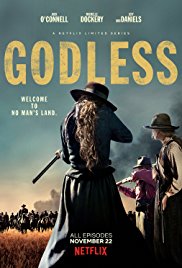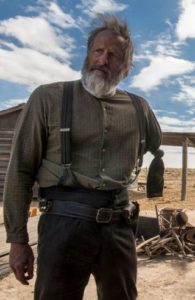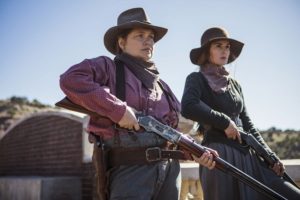 I recently finished binge watching Godless, the Netflix Western set in the fictional New Mexico town of LaBelle, which is comprised almost entirely of women, with the exception of the stray oldster and youngster, due to all the men folk being killed in one fell swoop in a mining accident.
I recently finished binge watching Godless, the Netflix Western set in the fictional New Mexico town of LaBelle, which is comprised almost entirely of women, with the exception of the stray oldster and youngster, due to all the men folk being killed in one fell swoop in a mining accident.
Roy Goode is on the run, having crossed his rogue-psycho-outlaw-gang-leader-adopted-father Frank Griffin. Hence the requisite Western bad guy-good guy storyline.
But the real fun is with the gun-toting, self-sufficient, utterly bad ass gals.
An Unlikely Ensemble
Michelle Dockery, of all people, in a complete one-eighty from her turn in Downton Abbey (yeah, wrap your head around that), is Alice Fletcher, a widow with her teenage son and Indian mother-in-law (played by the lovely Tantoo Cardinal of Black Robe fame) trying to scratch out an existence on their ranch outside of town. The injured Roy Goode, played by Jack O’Donnell, hides out on Alice’s ranch and she gets some wrangler work out of him for her trouble.
All the folks in LaBelle know that Frank is leaving a trail of carnage behind him looking for Roy, and that he’ll eventually figure out he’s at Alice’s. Their goal is to not end up as buzzard food when Frank ultimately hits town.
Frank Griffin is played by Jeff Daniels, and all I can say is I’ll never look at this actor the same way again. I always viewed him as a relative lightweight, the Dumb and Dumber guy, a sidelines type of character. (I know he’s done more substantial things, but I haven’t followed his career closely.) Frank is a  sadistic SOB, leading his band of marauders as they seem to spend an awful lot of time and energy looking for Roy. As the series progresses, Frank evolves into nothing short of vile, not just physically but cerebrally, which makes him all the scarier. Daniels brings a creepy realism and depth to this character.
sadistic SOB, leading his band of marauders as they seem to spend an awful lot of time and energy looking for Roy. As the series progresses, Frank evolves into nothing short of vile, not just physically but cerebrally, which makes him all the scarier. Daniels brings a creepy realism and depth to this character.
The mayor of LaBelle is the former mayor’s widow, Mary Agnes, played by the fabulous Merrit Weaver of Nurse Jackie fame (in another fun one-eighty of casting). She wears her dead husband’s clothes and has a female lover. She’s convinced the town can make a comeback from the mining accident, but actually making it happen is another thing. And that’s just one of the story lines working on the periphery that draw you in.
More Than Meets The Eye
There’s Alice’s son, who finds a quasi-surrogate father in Roy, or who at least shows him how to not be such a whiny adolescent. There’s the Quicksilver Mining Company and its band of slimeballs, looking to buy the mine and get it rolling again but at the price of the town giving up its control. There’s the sleazy newspaper editor who will do anything for a story. There’s Bill the sad-sack, widowed sheriff who’s losing his nerve and eyesight, who goes on a mission to find Griffin before he finds LaBelle. Whitey, Bill’s young sharp-shooting deputy, falls in love with a girl from the African American town of Blackton, located on the fringes of LaBelle, which of course is going to be tolerated by nobody. And there’s the story of Blackton itself, which could be its own mini-series.
Speaking of Sheriff Bill, his arc was one of the more interesting side stories. His wife is dead, he has two little kids, his sister is the self-appointed mayor of the town, and he’s losing his eyesight. He decides to go on a one man mission to intercept Frank before he makes it to LaBelle. Along the way he’s accompanied by an Indian ghost who tells him he has no shadow (the sign of a dead man). In the end he makes his way back to town, accomplishes his mission, gets his shadow back, and gets the girl.
As the sheriff, he isn’t depicted as a stereotypical hardass or incompetent nincompoop. His story is emphatic and you feel for the guy and really don’t expect him to make it all the way through. His story is a good one. And, he has a fabulous horse. I haven’t seen such a sweet buckskin since Lorne Greene’s Buck in Bonanza. Such a beautiful animal!
The Devil’s in the Details
The production value is off the charts. Costumes, settings, the smaller details of home interiors – it’s all there. I’m sure Hollywood has a whole department of Western authenticity. (See 3:10 to Yuma‘s extras for a fabulous education on the making of a realistic Western.)
The only disappointment – and this is common in almost every program I’ve ever seen that featured horses – was the audible hoof beats often do not match what the horse is actually doing. A horse is trotting and you hear a three beat stride. Vice versa. A single horse in the frame and it sounds like a stampede. Vice versa. Why is this so hard to get right? This was the case in practically the first scene of Godless, and I almost turned it off. But it was quickly forgiven.
The dialogue was another great facet in Godless. I tried to watch the HBO Western drama Deadwood several years ago. The language was so unnecessarily foul, I stopped after a couple of episodes. I’m not bothered by coarse language, but it was incessant and unnecessary – and more to the  matter, it didn’t ring true for me. I don’t believe people in the 1800s spoke quite that roughly, regardless of their difficult lots in life. Here, there was the occasional profanity, but the dialogue was totally believable and sounded natural. You could imagine these people actually saying these things under these circumstances.
matter, it didn’t ring true for me. I don’t believe people in the 1800s spoke quite that roughly, regardless of their difficult lots in life. Here, there was the occasional profanity, but the dialogue was totally believable and sounded natural. You could imagine these people actually saying these things under these circumstances.
(Another Western with terrific dialogue is True Grit – both versions. Even more fun is to compare the films to each other and to the book. Sorry, I could go on about this for days.)
Another area where Westerns can trip over authenticity is in their tack. I’m no expert on what was used when, but I know enough that D snaffles and spring loaded snaps weren’t around in the late 1800s. Godless, on its first pass anyway, seemed to have it right.
One thing that I often ask in historical pieces is, what are these people eating? And when? And more importantly, what are their horses eating? The backdrop of New Mexico is pretty arid, lots of wind and sand. You never see folks doing mundane, repetitious things like laundry or food prep, which took a lot of their time back in the day. And I do mean a LOT. I’m a logistics gal: how and from where did they get their supplies? Who was butchering cows? Where were the gardens? But I suppose the drudgery of day to day existence would make for a very boring story line. An hour of Alice beating clothes against a rock in the creek wouldn’t make for great drama.
There was opportunity to delve more into the stories of the surviving women and how they ran the town. Alice and Mary Agnes are the only characters who are fleshed out more than a little. Other than the mine, how could they attract people to settle in LaBelle? Was any marketing going on? Did they even have a chamber of commerce? I would have enjoyed seeing a little more of Mary Agnes’ acumen in running the town. The exchange between the town leaders and the Quicksilver Mining Company sleezeballs looking to buy the mine is an interesting one. Lots going on all the way around.
I do love me a good Western, and one with such strong female characters had me from the word go. The series has received its fair share of criticism in reviews about it being too feminist, not feminist enough, too much of this, not enough of that, blah blah blah.
I chose to not take it that seriously. It’s not a documentary, after all. This is just fun. Kudos to Netflix. Take off your spurs and sit a spell and enjoy this one.
